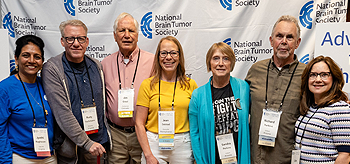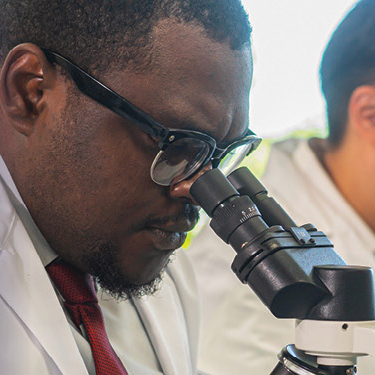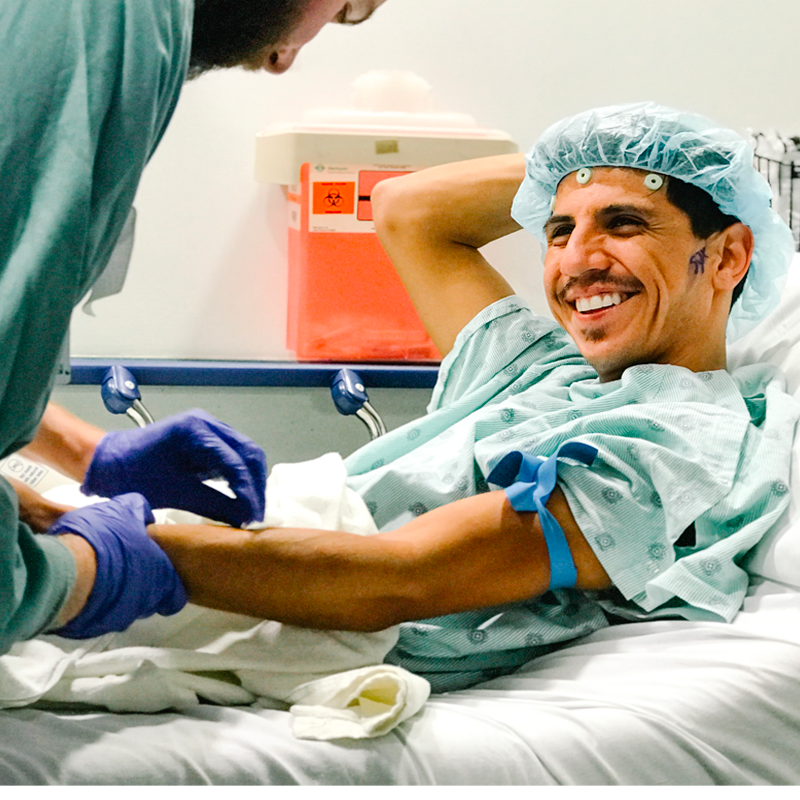A common misconception is that brain tumor clinical trials are only an option after multiple recurrences or as a last resort. In reality, there are five critical time points of eligibility, or windows of opportunity, when patients can consider brain tumor clinical trials — sometimes even before surgery or starting treatment.
Because eligibility often depends on where a patient is in their treatment timeline, missing a window can prevent patients from enrolling in certain trials. That’s why it’s so important to talk to your care team about clinical trials as early as possible — ideally right at diagnosis.
Through our MyTumorID campaign, the National Brain Tumor Society (NBTS) is empowering patients and caregivers to ask about clinical trials upfront — even before surgery — so you don’t miss an opportunity later.
“Many clinical trials require a patient to have completed biomarker testing or utilize biomarker testing results for trial eligibility, so it’s important to discuss biomarker testing with either your neurosurgeon or your neuro-oncologist or oncologist right away upon diagnosis, so that you have the ability to have that information if you do want to seek a clinical trial,” said Jenna Tozzi, RN, NBTS’s senior director of community.
Why is there eligibility criteria for clinical trials?
Every clinical trial has its own set of rules regarding who can participate, called inclusion and exclusion criteria, based on factors such as age, overall health, stage of the disease, and previous treatments. Inclusion and exclusion criteria are there to protect patients and help the trial collect the most precise, safest data possible.
There are more than 100 types of brain tumors, so the inclusion and exclusion criteria listed in the clinical trial description often include specific requirements, such as certain biomarkers, to help patients understand exactly who is eligible to participate.
“Biomarkers help narrow down a list of clinical trials for patients specific to their molecular characteristics and classification of tumor,” Jenna explained. “While it may feel like having — or not having — a certain biomarker or genetic mutation limits your clinical trial options, it’s actually helping you focus on the most promising opportunities. In the past, clinical trials would have been grouped together by tumor type without biomarker specificity. Now, researchers are really able to separate those trials and be more specific for your tumor type.”
Inclusion Criteria
Examples of inclusion criteria include:
- Specific diagnosis (e.g., glioblastoma, low-grade glioma, metastatic brain tumor, etc.)
- Biomarker or genetic mutation (e.g., IDH mutation, MGMT methylation, BRAF mutation)
- Previous treatments (e.g., must have completed standard radiation or chemotherapy first, or must not have started chemotherapy or radiation)
- Age range (e.g., adults over 18, children under 18)
- Disease stage (newly diagnosed or recurrent disease)
- Lab values (e.g., adequate liver, kidney, and bone marrow function based on blood tests)
- Functional status (e.g., Karnofsky Performance Scale score of 70 or above)
When considering participation in a clinical trial, one factor that doctors often take into account is your Karnofsky Performance Scale (KPS) score. It’s a simple way to measure how well you’re able to go about your daily life independently — things like getting dressed, cooking meals, or working. The scale runs from 100 (meaning you’re feeling great and fully active) down to 0. Many trials establish a minimum KPS score, typically around 70 or higher, to ensure participants are physically strong enough to tolerate the treatment.
Exclusion Criteria
Before starting any type of treatment, NBTS encourages you to ask if the treatment will impact clinical trial enrollment at any point. Beginning a new therapy doesn’t automatically rule you out from a clinical trial, but it’s important to plan ahead and ask about potential impacts on eligibility.
Examples of treatment that may impact eligibility include:
- Tumor Treating Fields (TTFs)
- Immunotherapy
- Avastin
- Steroids
- Anticonvulsants
Jenna shared, “Patients will often ask, ‘I’m starting on Avastin, is this going to exclude me from clinical trials down the road?’ Not necessarily. The inclusion and exclusion criteria of a trial protocol often provides patients with an understanding of a ‘washout period,’ which is a time frame for how long someone needs to have stopped a medication. Sometimes it could be three months, for example. A trial could also require you to stop your Optune device, but that doesn’t mean you couldn’t restart it later.”
When are you eligible for a clinical trial?
There are five key windows of opportunity when a patient with a brain tumor may be eligible to enroll in a clinical trial — not just when their standard of care treatments are exhausted.
1. Newly Diagnosed – Before Surgery
One of the significant challenges in treating brain tumors is overcoming the blood-brain barrier to reach the tumor. That’s why clinical trials involving surgery are of great interest to researchers.
Some clinical trials are available for newly diagnosed patients even before their initial surgery.
These clinical trials may include surgery as part of their experimental therapy, so they may be using surgery and a dye to help the tumor cells light up during the craniotomy. It could involve implanting something in the tumor space after the tumor is removed, such as GammaTile therapy (radiation wafers that coat the entire area where the tumor has been removed).
Note: Some trials require surgery to take place at specific participating hospitals.
Katherine Pahler, RN, NBTS’s patient navigator, said, “Where an individual receives surgery is important because there are some clinical trials — if they are associated with surgery or take place prior to starting the standard of care — that may require that the procedure be performed at the clinical site.”
2. Newly Diagnosed – Before Standard of Care Treatment
According to the National Comprehensive Cancer Network’s (NCCN) 2024 guidelines, clinical trials can be an initial treatment after surgery for many brain tumor types.
“I think there’s this misconception that patients can either do standard of care or a clinical trial,” Jenna said. “In reality, a lot of these clinical trials for newly diagnosed patients include the standard of care, but may add in some sort of experimental treatment, thinking there may be some synergistic effect with the standard of care or it may boost the standard of care so that you see a greater and better response.”
Clinical trials often look to answer the question, “What can we do in addition to the standard of care?” When patients enroll in a clinical trial before beginning the standard of care (chemotherapy and/or radiation), they may be able to try a new therapy — drug, device, or immunotherapy — in addition to the standard of care.
“I advocated for my husband to get enrolled in a clinical trial following his glioblastoma diagnosis,” said Jessica D. “We considered a few options and made an informed decision about which clinical trial made the most sense for us.”
3. Newly Diagnosed – After Standard of Care, Before Maintenance Therapy
A small number of clinical trials are available after the patient receives the standard of care treatment, but before they enter the maintenance phase of treatment.
However, many of these trials require patients to be enrolled in them right after surgery, even though the trial doesn’t begin until after the standard of care treatment concludes.
“For individuals whose tumor is unmethylated, some clinical trials may indicate that chemotherapy is not required as part of participation,” Katherine explained. “This is important to understand, as trials are increasingly aligning with what is known to be most effective based on an individual’s diagnosis and biomarkers. Clinical trials are adapting their inclusion and exclusion criteria to reflect this evolving knowledge and to become more inclusive.”
4. Recurrence – Before Surgery
There are more trials specifically designed for recurrent brain tumors — meaning after the tumor comes back — because there “really is no established standard of care for most brain tumor types when a brain tumor recurs” according to Jenna.
As with the newly diagnosed patients, some clinical trials for recurrent tumors are only available to patients before they undergo surgery to biopsy and/or resect the tumor, because the researchers want to explore the use of immunotherapy before surgery or evaluate therapies delivered during surgery.
5. Recurrence – After Surgery
The final critical point of eligibility for a clinical trial is in recurrent brain tumors following surgery.
After surgery, patients have new pathology information and are often still eligible based on health status.
Finding a Clinical Trial
Patients and care partners can ask their health care provider if they know of any open clinical trials within their hospital system. If there aren’t any trials available, ask to look outside that health system at surrounding hospitals or centers. Resources like NBTS’s Personalized Support & Navigation team can help patients and caregivers look outside their area and even nationwide for clinical trial opportunities.
“We often ask if there are states or cities where you have family members or a support system in place so that you have someone you can stay with during treatment,” Jenna said.
The content on this website is for informational and educational purposes only. It does not constitute medical advice. Always consult a professional for your particular needs and circumstances before making medical, professional, legal, or financial decisions.





